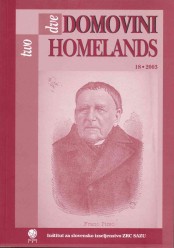ECONOMIC CIRCUMSTANCES IN CARNIOLA DURING PIRC’S TIME
Abstract
We understand Pirc’s time as the period before his leaving for America, that is between the years 1785 and 1835, and after his return to the homeland, from 1873 to 1880. In general, we can say Carniola was at Pirc’s departure still just as feudal as it was already capitalist on his return. Generally, we can denote that period as one of the turning points in Slovene history. Joseph II was continuing the dismantling of feudalism that his mother started; the 1848 revolution exterminated it. The Slovene peasant, whom Pirc intended so much attention, became a free citizen.
In economic aspect and in agrarian sphere in particular this was the time of final victory of potato, corn and clover, which entered into Slovene agriculture global changes. The progressing capitalism destroyed the self-sufficiency of agriculture. True, the peasant did no more experience mass famine, the last was in the years 1816/1817, but was becoming increasingly dependent on market economy. The building of the railway Vienna-Triest and its sections destroyed the centuries old sources of income from the non-agrarian activity that were for the Slovene passive agrarian of vital significance. The iron foundry in Carniola fell in ruins. All the mentioned lead the agrarian economy to a deep crisis, which the cooperative movement – along massive emigration – was successfully solving.
The activity of Franc Pirc should be evaluated in the spirit of the time and space. We should derive from the physiocratic economic theory, which was the spine of economic principles of Joseph II and his counsellors. Care for a more profitable and successful agriculture was an official state economic policy in which especially the Agricultural societies joined and thus in theoretic and in practice fields promoted agriculture. As lords of the castles were because of social differences less successful with the task, the more important were clergymen who were easier and more frequently, and least but not last with the authority of the Church carrying out the modernisation of the countryside. Franc Pirc is consequently just one of the large group of Slovene priests of whom besides him Josip Vrtovec and Janez Zalokar impressed in Slovene historical recollection. Characteristic for the mentioned is they were not only practical but as well writers of important agrarian-technical books. A particularity of Franc Pirc is that he attempted as a missionary to transfer Slovene economic-social experience among American Indians. In that view, he presented a significant supplement to the practice of the missionary Friderik Baraga who was on the basis of experience from the homeland creating the general civilisation development of the Indians especially in the field of language.
Downloads
Downloads
Published
How to Cite
Issue
Section
License

This work is licensed under a Creative Commons Attribution-NonCommercial-NoDerivatives 4.0 International License.
Authors guarantee that the work is their own original creation and does not infringe any statutory or common-law copyright or any proprietary right of any third party. In case of claims by third parties, authors commit their self to defend the interests of the publisher, and shall cover any potential costs.
More in: Submission chapter





